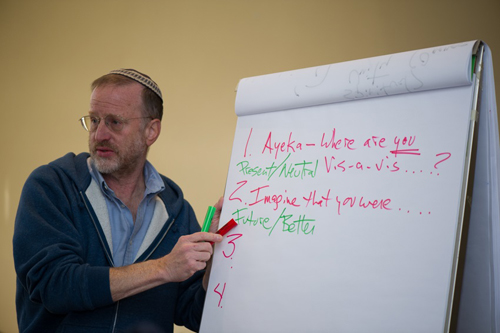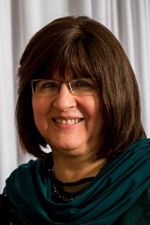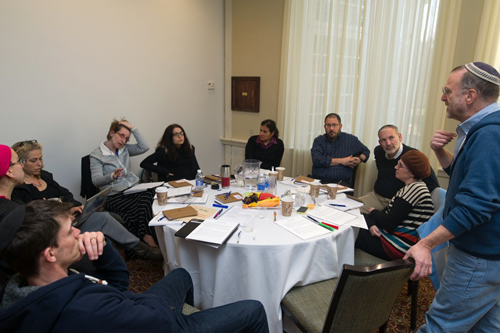
Sam Ulrich Studio)
By Toby Klein Greenwald

EFRAT, Israel — In Becoming a Soulful Educator, by Rabbi Aryeh Ben David, every chapter has “aha” moments and statements that you will want to frame and hang on your wall, and he is liberal in attributing ideas to those who have inspired him – Rav Avraham Yitzhak Kook, Peter Palmer, and others. Among those living today, he says that Rabbi Dov Berkovits, one of the founders of Pardes, with whom Ben David taught, had a profound influence on his thinking.
Even if you are an experienced teacher, some ideas that are familiar to you now, may not have been when you were 24. Wherever you are in your career, this book will help you shortcut the process to soulful education. I spoke with Ben David.
How many educators have you reached so far?
“We have directly presented to at least five thousand. Based on a six month evaluation of alumni done two years ago, over 90% said it made them better listeners and 63% said their listening was affected ‘a lot’ or ‘very much.’”
Aren’t there many good teachers out there who do this intuitively?
“There are a lot of individual good teachers are there but AYEKA is the only system that teachers can learn from and have conversations about. It is for staffs at schools who train and work together, developing a common language and best practices based on the system.”
Do teachers who are natural “stars” in the classroom also need this method?
“Good teachers are often charismatic and there is a danger in that. There is power in the classroom; through the AYEKA method, we teach them not how to be center stage, but how to evoke, how to create a space for the students to find their own space.”
In June Ben David gave sessions at two schools in Los Angeles – Shalhevet and Milken High School. He was also at the Kohelet Yeshiva in Philadelphia and his staff were in Stamford, Connecticut, at the Bi-Cultural Middle School. In each instance, they worked with 6-8 teachers. “We train them for a year. It’s a nine-month program. Then there is follow up to make sure it sticks. We have hundreds of testimonials.
“When I started doing this ten years ago some people thought I was nuts. Five years ago they started listening. Now we’re swamped by principals and teachers who say they need more. I presented recently to 400 Chabad shluchim, so it’s from Reform to Chabad.” However, he says, they have not yet succeeded in penetrating the haredi schools.
One of the chapters I found the most intriguing was “Soulful Space” which includes the key definition: “The first task in soulful education is to create an environment of safe space that is soul-friendly.”
“This ‘safe space,’” he writes, “includes no cynicism, judgment, attacking or criticizing. By nature, it eliminates the need to be defensive. People are taught to not be so involved in multi-tasking that leads to neglect.” AYEKA’s goal is to train teachers so they will not be tempted to be cynical or sarcastic even though that may give them a higher status in the eyes of certain students.

“In the rabbinic world,” says Ben David, “you want to master the material and show others your mastery.” In contrast, he writes in his book, “Safe space is a setting in which a person’s soul is respected…Safe space enables us to let down our guard without concern that we will be wounded or neglected.
“Most educational environments thrive on debate that can sometimes become angry and bitter. The Beit Midrash is known for especially brutal arguments. The Talmud refers to two people studying together as ‘beating each other’ to sharpen their thinking. I remember my study partner, Daniel, and myself often screaming at each other while we studied Gemara. … Adrenaline would flow as we poised to intellectually spar with each other.
“But the soul engages differently than the mind. It is fragile and shy, like an amoeba. When an amoeba is attacked, it withdraws into itself and firms up its walls. Our souls withdraw from conflict and judgment.
“It is not easy to engage personally. We fear being judged by others. We carefully guard what we share and with whom, building walls around the more vulnerable parts of our lives.”
How ridicule can destroy
Ben David describes an event that occurred at the beginning of his teaching career, when a woman spoke about her personal experience with prayer and another woman, very demonstratively, rolled her eyes. “No one wanted to risk becoming the next target of rolling eyes. Needless to say, the woman who had shared something personal was crushed. One moment of rolling eyes shut down the whole group.” The group remained emotionally closed for the duration of their time together. “Looking back now, it is clear to me what I should have done to fix the situation, but at the time I was utterly clueless.
“I should have paused the conversation and in the most respectful way said to the rolling eyes participant: ‘I know that you would never intentionally hurt someone, but it is painful to be the object of rolling-eyes. We need to maintain a space in which everyone can express their opinions without fear of judgment.’ I imagine that she would have then apologized and we could have carried on.”
Ben David learned most of the lessons that he morphed into his method through personal experience. He believes that these sensitivities can – and should — be taught to teachers who are at the beginning of their careers, so their early teaching years will not leave casualties in their wake. “It’s important that it be done while they are in the classroom [as opposed to teachers’ colleges], so they can see the immediate results, not as a theory divorced from practice in real time.”
He asked one high school teacher if he would allow students to beat each other up in the classroom. When he said, “Of course not,” Ben David asked him, “Then why do you allow cynicism? Isn’t that a form of beating up – just verbally instead of physically?”
A chilling story
“For years I taught Talmud,” writes Ben David. “One year, I had a student who spoke a bit too loudly and a bit too long in class. It often grated on the other students. I remember one class vividly. I was writing on the board and had my back to the students. He was making a point, a bit too loudly and a bit too long. All of a sudden, a woman in the class burst out, ‘Are you ever going to finish? You’re driving me nuts!’
“I froze. My hand was on the blackboard; I stopped writing mid-sentence. I remember the panicked thoughts racing through my mind: ‘What should I do now? That outburst was so cutting and devastating. What is he thinking now? What is she thinking now? What should I do?’ “And then I did the worst thing possible. I ignored what happened.
“I said to myself, ‘Aryeh, you’re not a social worker or therapist.’ “So I turned to the class and said, ‘Can we get back to learning, to the Gemara? Let’s focus.’
“That was the worst possible thing I could have done. I was giving my students the educational message that the content of learning was more important than our moral behavior. Needless to say, after this eruption, the students could not concentrate, and certainly would not engage personally.”
He tells a story of teaching a class of 17-year-old boys in New York, at the beginning of which he told them they’d be “functioning in a cynicism-free zone.” One kid looked at him and said, “You just asked me to take off my whole personality. I’m a cynic.” Ben David insisted and “Sixty minutes later, this same…boy wrote a personal and heart-wrenching poem that I still have. When given the chance to take off his protective armor, he sincerely and heartfully engaged.”
A long term process
Ayeka has six essential steps. Ben David emphasizes that “We cannot multi-task the soul” and says, “I strongly recommend that teachers compose a short mantra they can recite before entering their classes. Something that forces them to stop, focus, and transition safely into their teaching.”
He cites the three footsteps backward and then forward in the Amida prayer as an example of transitioning into prayer, the circling of our hands before we light candles Friday night, and the blessings we say upon food.
When he’s asked teachers what throws them off their zone while teaching, their answers have been seeing students looking bored, remembering their to-do list, the air-conditioning not working, thinking about previous conversations, an annoying student, making a Freudian slip and more.
“When we are ‘thrown off our zone,” he writes, “it is normal to need a moment to re-transition …..”
Introducing the Learning
This Step Two teaches the teacher to answer the question “Ayeka”—“Where are YOU – in this subject?”
I was surprised to read Ben David’s claim that teachers “have been conditioned from an early age to view the classroom as the site of exclusively intellectual interaction. It is not a place for emotional, spiritual, or personal engagement.” This was not my experience either as a student or a teacher and he did admit that female teachers, as a group, are somewhat ahead of the game when it comes to engaging personally with students.
He says, “If you were to ask them what is more important, regarding if information is more important, or being affected is more important (for the student), they’d all say that being affected is more important.”
Ben David recently asked a group of veteran educators what would be different about their teaching if they could let go of their fears and insecurities in the classroom. They responded that they would be happier in their teaching, more spontaneous, more open to questions, more willing to risk going “off-script” and love their students for who they are.
What then holds them back from letting go of their classroom fears and anxiety? The worry about how they will appear in the students’ eyes, or lack of knowledge, the need to be admired or the need for control. He hopes that his methods will give them courage.
“Mindful Engagement” is Step Three. ”Education should not only be mastering data, but using the information to advance our personal clarity, to grow and deepen ourselves… to see everything with new eyes,” he writes. Regarding “Heartful Engagement,” Step Four, he quotes the Kabbalah, which says, “There are three primary voices of the soul: the mind (neshama), the heart (ruach), and the body (nefesh).[1] The soul utilizes these channels to speak to us in different and distinct ways. Spiritual unity involves accessing and harmonizing these three voices of the soul.”
Step #4 moves from: “What do the sources say?” to: “What do the sources say – to me?”
He explains then all in depth: No competing, No self-judgment. No self-censoring…The Midrash audaciously observes that at the Mount Sinai revelation, ‘Everyone heard a different voice of God.’”[2]
The four seminal questions are: “Where are you (‘Ayeka?’) regarding the subject we studied? How do you think these ideas can affect your life? What do you think are the obstacles for you to reach this future reality? …and: If you could give yourself one small but practical piece of advice to help you grow…what piece of advice would you give yourself?”
“The most important question is question #2, and this is also the question that invokes Rav Kook’s emphasis on imagination. “Imagination is our power to envision a reality that does not exist yet.” He says that soulful education is always future-based — imagining a better self, and aiming for learning to have an impact after the class, to include the student in rebuilding “the Garden of Eden.”
Talk to us about power and gender.
“In my experience the women teachers usually have greater emotional intelligence and are more aware of the need to develop a relationship between the students and the sources. The primarily male experience of the beit midrash has inculcated a more a greater desire to control and master the sources without personalizing them. However, I have also noticed a tendency among women teachers to try and emulate the male role model of mastery at the expense of the personal relating to the sources…” Some female educators would take issue with that last statement.
Steps Three and Four (Mindful & Heartful Engagement) can be summarized in a brief sentence: “Learn – Process – Share.”
“To fully bring the learning into our hearts, we need talk about what we have written. We need to have a heart-to-heart conversation. At Ayeka, we call this exercise a “Spiritual Chevruta”[3] (partnership), and have drawn up guidelines to encourage a personal and authentic experience. It is based on confidentiality, quality listening and no giving of advice…Only when the listener is fully present and focused can the speaker then begin to access and discover his or her true story.”
And perhaps then, whether teacher or student, through “Ayeka” – “Where are you?” s/he can begin to find the answer to “Where am I?”
They are seeking new school partners for the coming year.
Read more about Ayeka at: www.ayeka.org.il
*
The author is an educator, the award-winning theater director of Raise Your Spirits Theatre and editor of WholeFamily.com.
[1]
Nefesh HaChaim, Chapter 14.
[2]
Midrash Raba Exodus, Chapter 29.
[3]
See Appendix – Spiritual Chevruta